Setting up a turtle tank might get confusing, especially if you are not familiar with the needs of your pet. A healthy reptile habitat needs a heat lamp because turtles are coldblooded. Using a regular light bulb is not recommended, because the heat it emits often isn’t enough for the needs of aquatic and semi-aquatic turtles.

Apart from the heat, a turtle also requires lights that emit in the UVA and UVB spectrum. These are usually specific lighting fixtures designed for the basking areas of reptiles.
In this article, I’ll review some of the heating lamps that I know would work for turtles, and I will also teach you what the right UV lighting is for your pet.
Let’s get to it!
See Also: The 14 Types of Freshwater Turtles: The Best Aquarium Companions for a comprehensive list of the most popular pet turtle varieties!
Why Do Pet Turtles Need a Basking Lamp?
As coldblooded creatures, turtles can’t control their body temperature.
In order to maintain a higher temperature which helps with fighting off pathogens, turtles need to bask in the sunlight for multiple hours a day.
When basking, a turtle absorbs different spectrums of light that encourage healthy body processes, regulating behavior, the production of vitamin D, and the animal’s metabolism.
That being said, pet turtles that are kept indoors would need a heat lamp because:
A basking lamp is essential for your pet turtles because in home conditions they won’t have regular access to heat and light from the sun to regulate their body temperature. In a captive environment, the warmth from the Sun’s rays is replaced by the one coming from a heat lamp. Your turtles will use the lamp to bask and keep themselves warm, reducing the risk of fatal illness.
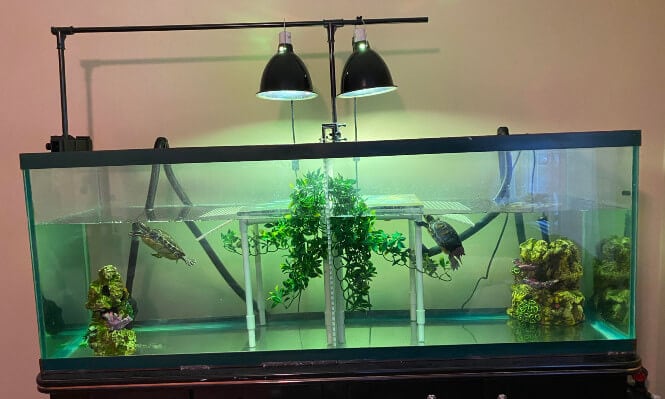
Almost all turtles need a heat lamp and a basking spot. Here are some of the more common pet turtles that require a heating source:
- Musk turtles
- African sideneck turtles
- Box turtles
- Red Eared Sliders
- Painted turtles
- Snapping turtles will rarely bask, but they still need a heat lamp
Some turtle species will bask more than others.
For example, people who own a musk turtle often say they don’t see it basking. However, this doesn’t mean that it does not need a basking lamp at all.
The different roles of UVA and UVB light
Before I explain what role UVA and UVB lights play in the development of a turtle, let me clarify what those are.
In short, UVA and UVB lights are part of the sunlight that a reptile would get in the wild.
These light rays belong to the ultraviolet spectrum, which is invisible to the human eye, but visible for some animals, including turtles.
So, what are the roles of UVA and UVB light bulbs for the turtles?
The light within the UVA spectrum is responsible for improving a turtle’s appetite, breeding behavior, and physical activity during the day.
UVB light assists in producing healthy levels of Vitamin D within the body of a turtle.
Vitamin D helps the bones and the shell of your pet turtle to absorb Calcium, making them stronger.
If there is no lamp that emits enough UVB light in your turtle’s habitat, then at some point the pet will likely develop bone issues.
In most cases, these issues would be what’s known as Metabolic Bone Disorder, which, according to most experts, is quite painful for the animal and often has a fatal outcome.
UV light bulbs provide both of these rays and make sure that your turtle lives a long and happy life.
The ability of turtles to see UV light may be an indicator of how important its role is in their day-to-day life.
The kind of light bulbs that aquatic turtles need to thrive
You’ll likely come across many turtle keepers who resort to regular light bulbs as a source of heat for their aquatic reptiles.
For the sake of argument, regular incandescent bulbs do give off some heat and are usually cheaper than a heat lamp designed for turtles.
However, I would not recommend using a regular household bulb as a heating source for your turtle because:
- regular light bulbs last much less and also emit less heat than a special heating lamp for turtles;
- regular bulbs are often prone to shattering from splashes with cool water and humidity;
- they are also shifted towards producing visible light and not the kind that’s needed for an aquatic turtle (though they do emit some UVA);
Having said that, the light requirements for all aquatic turtles include a few kinds of light bulbs.
- A basking lamp should give off enough heat which your aquatic turtle will use to maintain good digestion and a stronger immune system. The heat lamp imitates the sun rays and the warmth they produce.
- Another type of bulb turtles would need is one that produces UVB and UVA light. Both UVA and UVB rays play an important role in the development of your turtle.
To lessen your confusion, I will say that in practice turtle keepers get one lamp that emits heat and UVA rays, and a separate bulb for the special UVB light.
For optimal electricity consumption, the heat bulb is usually incandescent or halogen in nature and the UVB lamp is a fluorescent one.
How long should you keep the basking lamp ON for a pet turtle?
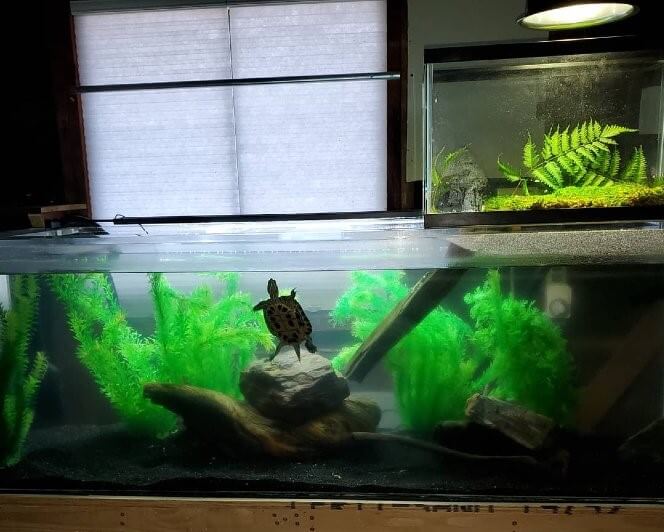
Turtles live according to the 24 hour-long day and night cycle. They need to bask in heat and light while staying awake during the day and sleep in a dark place during the night.
With that in mind, you need to recreate this natural cycle as close as you can in your turtle tank:
You should keep the basking light and the source of UVB light on for around 10 to 12 hours per day. During summer you can leave both lamps on for up to 14 hours as it would be if your turtle was in the wild.
Keeping the lighting in your turtle tank on for 24 hours may disturb your pet’s sleeping and eating patterns.
Prolonged light cycles may result in digestion and overall health issues for your pet turtle.
If you think you might forget counting the hours every day, you should consider getting a mechanical outlet timer.
Most turtle keepers use these to schedule the day and night cycle over their turtle tanks.
I can confirm that these timer outlets are usually very easy to use, and will save you time and scheduling hassle.
Plus, a lot of them are coming within a reasonable price range.
Anyway, there are also infrared heat lamps designed for aquatic turtle habitats that produce almost no visible light but keep the basking area in the tank warm.
Infrared heating lamps are usually important if you’re looking after aquatic turtle hatchlings, who need more warmth in their early stages of life.
The hatchlings would also sleep in the basking area because they still won’t be able to hold their breath long enough to spend the night underwater.
Should the heat lamp be kept on at night?
As long as the heat lamp emits mostly infrared and almost no visible light you can leave it on at night.
Infrared basking lights will not disrupt the sleep cycle of your aquatic or semi-aquatic turtle.
However, when it comes to bright heating lamps, you should use the same schedule rules as for the UV lamp and leave them on for no more than 10 to 14 hours a day.
You need to ask yourself some questions before deciding whether or not to leave the heat lamps in your turtle tank on at night:
- What is the temperature in the room where you keep the tank during the night?
- Does the water temperature in the tank remain above 65 ºF during the night?
- Is your turtle still growing?
- Is it a hatchling?
In general, if your turtle tank doesn’t have a water heater or the room gets too cold, you can leave your infrared heat lamp on during the night.
In general, the majority of pet turtles spend their sleeping hours either in the water or in a colder area of the tank, unless sick.
Also, mature turtles don’t really rely on heating at night, unlike hatchlings.
What Wattage should the Heating Bulb be for Turtles?
Another thing to consider, when setting up a turtle habitat, is how many Watts should the heating bulb be.
Should it be 50, 75, or 100 Watts, which are the most commonly sold varieties?
What I concluded, after having set up a few turtle tanks, is that the Wattage itself is not the most important thing when picking up a heating lamp.
What matters the most is the temperature of your turtle’s basking spot.
Regardless of bulb Wattage, your goal should be to bring the temperature of the basking area between 90 and 95 °F.
Put the heating lamp too close and it may burn the eyes and skin of your turtle, put it too far away, and your aquatic pet may become sick.
If you have a smaller turtle tank, such as a 55-gallon one with a basking area that’s not too big, a 50 Watt heating bulb will likely do a great job.
But even if you end up with a lamp that has a higher Wattage, just fix it farther away from the basking area and make sure the temperature reaches no more than 95 °F degrees in one spot.
For example, a 50-Watt heating bulb can be fixed around 7 inches away from the basking spot of your turtle. If the bulb is a 100-Watt one you will need to place it at least 10 inches away from the basking area.
In case you have a bigger tank or you have more than one turtle, you can get a 75 or 100-Watt bulb to make sure the produced heat will be enough to keep the temperature around 90 °F degrees.
The easiest way to measure whether or not the needed temperature in the basking area has been reached is by using an inexpensive infrared thermometer. Zoo Med ReptiTemp is one good example of what you could use to measure the heat, but there are more options out there.
What I would recommend here is to position the heating bulb in such a way that there’s a variety of surface temperatures across the basking ramp.
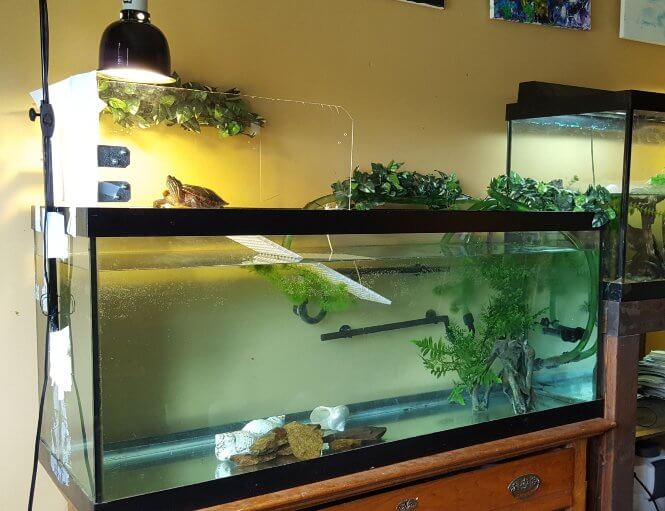
This way your pet turtle will move around until it finds its perfect basking spot according to its needs.
Having a sizable turtle basking ramp helps with that (click to check one out on Amazon and compare its pricing with Chewy’s here).
The one I just showed you on Amazon would fit the dimensions of most standard rectangular aquariums.
The Top 6 Heat (and UVB) Lamps for a Turtle Tank
| Lamp: | Summary: | UVB light included: |
|---|---|---|
| 1. Zoo Med Aquatic Heat Ligthing Kit | Best All-in-one lighting combo for beginners | Yes |
| 2. Fluker’s | Best for heating during the night | No |
| 3. Exo Terra Basking Lamp | Best for a standalone source of heat and UVA light | No |
| 4. Exo Terra UVB Bulb | Best for standalone source of UVB light | Yes |
| 5. NICREW ClassicLED | Best for turtle viewing | No |
| 6. Buddypupp Basking Lamp | All-in-one kit on a tight budget | Yes |
Generally, we can divide the UVB lights for turtles into two categories:
- tubes
- compact ones
I’m not an expert in tubular lights and my experience shows that they’re not a great fit for a turtle habitat as they suit land-based reptiles better.
So in this section, I will only review compact heat (and UVB) light bulbs that I have used and I’m familiar with.
With that being said, here are my favorite picks when it comes to the best heat and UVB lamps for a turtle tank:
1. Zoo Med Aquatic Turtle UVB & Heat Lighting Kit – Best Combo Kit
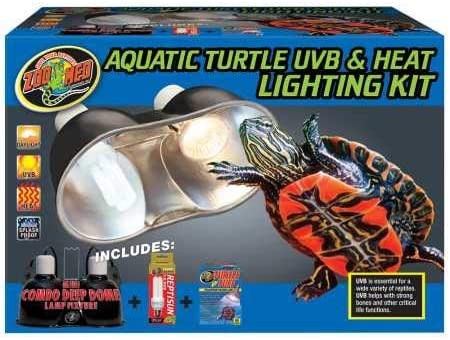
Click to compare pricing + see MORE photos of this product at:
I consider this lighting combo very beginner-friendly because the kit comes with all that a new aquatic turtle habitat may need.
In case you just started taking care of your turtle, or you want to save some time from researching different light bulbs, Zoo Med’s all-in-one lighting combo is for you.
I used this lighting kit the first year of getting my Red Eared Slider turtle.
My turtle immediately found its perfect heat spot on the ramp and started basking its shell off.
From this point on, he grew really fast and I suspect that these lamps played a significant role in its development.
What I like about Zoo Med’s all-in-one lighting kit is that it comes with a UVB bulb and a heat lamp that produces UVA light as well (a classic setup as I mentioned above).
The heating lamp emits enough warmth to provide your pet turtle with a comfortable basking area.
This turtle basking lamp is also a halogen one, which makes it more durable in the long run.
The best thing about the heat lamp, however, is that it’s splashproof. Turtles get really excited sometimes and can splash a lot of water, which may cause a hot bulb to shatter.
Anyway, the second bulb is fluorescent and emits around 5% of UVB rays which is within the recommended range for turtles by most experts.
The UV bulb is not labeled as “splashproof” but fluorescent lamps are more durable in general and don’t tend to shatter when cool water gets on them.
The combo of a heating halogen and a UVB fluorescent bulb also saves on electricity bills and is more long-lasting.
The domes are deep and made of aluminum, which makes them safer and a good option for a light reflector.
Each lamp has its own switch, thus you can use them separately.

One of the downsides in the Zoo Med aquatic kit is that it lacks a lamp stand.
Depending on your setup, you might spend a few long moments trying to fix the lighting fixtures.
Though I think it may be a sneaky marketing trick to separate the two products, you could just use Zoo Med’s reptile lamp stand (which you can check here on Amazon or here on Chewy).
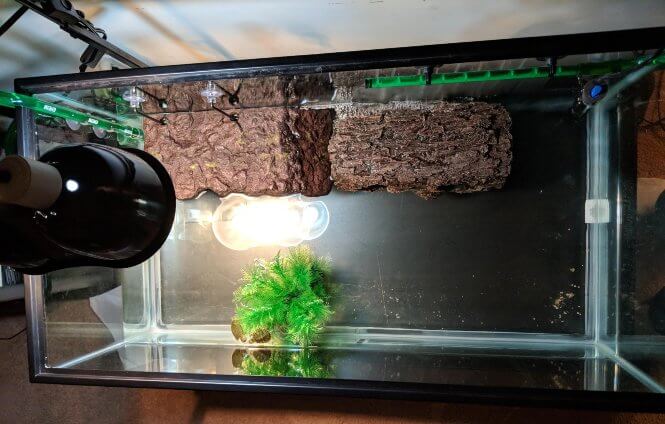
It will do a fantastic job of keeping the double-dome in place.
When it’s time to change the bulbs, make sure you replace them with Zoo Med’s bulbs only.
Otherwise, your turtle may not end up with the same balanced light and heat distribution because of how the dome is designed.
Plus, Zoo Med’s turtle lamps are splashproof.
ADVANTAGES:- The two bulbs emit all your turtle needs – UVB, UVA, and heat.
- The Splashproof heating lamp is halogen and therefore more durable.
- UVB lamp is fluorescent which means it’s very unlikely that it will shatter or explode.
- A good overall price for everything that the kit contains.
- Deep aluminium domes, covering both of the bulbs so that you won’t have to look at them.
- Both lamps have different switches so you can use them separately.
- The fixture comes with no stand
2. Fluker’s Ceramic Heat Emitter – Best Night Heating Lamp
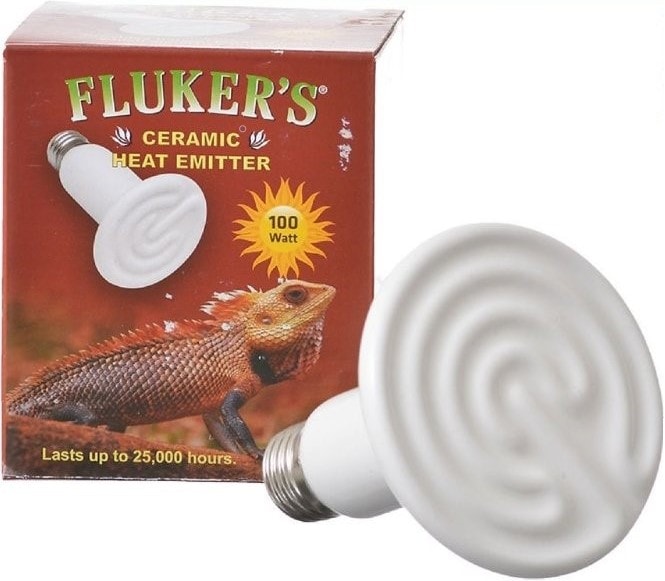
Click to compare pricing + see MORE photos of this product at:
I recommend getting Fluker’s Ceramic Heat Emitter if your home gets too cold at night.
This heating lamp is ideal for turtle habitats that may become too chilly during winter.
Fluker’s infrared lamp produces no visible light and it doesn’t disturb the sleeping cycle of your turtle.
This turtle lamp is also ideal for hatchlings who sleep outside of the water or sick turtles that need a higher body temperature at night.
The Fluker’s Ceramic Heat Emitter is compact, fits any turtle tank, and heats the basking area evenly.
It comes in a few varieties: 60 Watts, 100 Watts, and 150 watts.
Something to have in mind before taking this turtle lamp home is that it gets really hot and it should be run with caution.
In my experience, you should never use it with plastic sockets as they will melt away. I would just get Fluker’s clamp lamp socket (you can also check it out on Chewy) and be done with it.
One thing I found slightly inconvenient when I got this lamp was the smell I felt after I switched It on for the first time.
My turtle played it cool and did not seem bothered by the smell.
A few hours later, the smell was gone, and everything was fine, but I kept my eye on the lamp to make sure it functions without any issues. And it did.
So if you end up getting Fluker’s Ceramic Heat Emitter, I recommend letting it run for a couple of hours outside of the turtle enclosure to let the initial fumes gas off.
ADVANTAGES:- Ideal as a night heat lamp in a turtle habitat that gets cold at night.
- Only emits infrared light and heat, so it doesn’t disturb your pet turtle’s sleeping cycle.
- Recommended for hatchlings that need to sleep outside of the water.
- Recommended for sick turtles that need to maintain a higher body temperature during the night.
- Very well priced.
- Compact size.
- Compatible with deep and clamp domes.
- Produces smelly fumes the very first time you switch it on. The fumes gas-off in the next couple of hours and never come back.
- Your turtle tank will need a separate source of UVB and UVA light.
3. Exo Terra Swamp Basking Spot Lamp – Best for Heating and UVA light
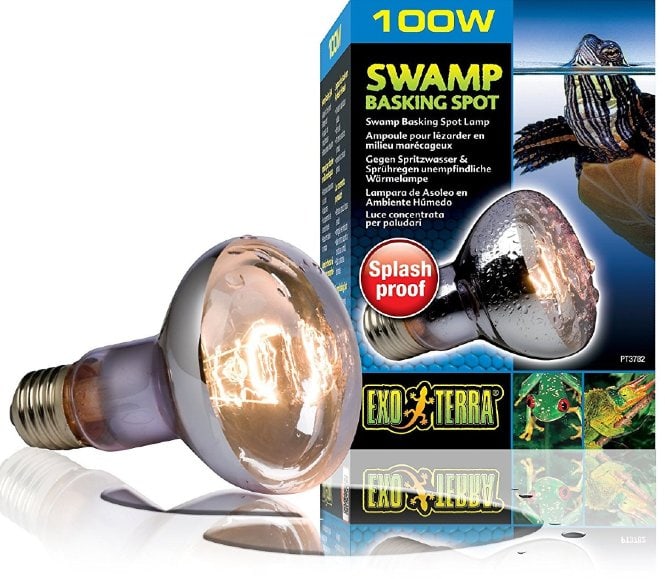
Click to compare pricing + see MORE photos of this product at:
Excellent for all types of terrariums and tanks, the Exo Terra’s Swamp Basking Spot lamp gives the needed UVA light to your turtle.
This lamp will heat the basking spot of your pet but it will not emit UVB light.
The Swamp Basking Spot Lamp is a great standalone bulb if you’ve decided to get separate bulbs for UVA and UVB rays.
It doesn’t come with any fixture though, so you’ll need to order one along with your new turtle lamp.
What I really like about this light bulb is that it’s splashproof as it says on the package.
And before you ask – yes, I have witnessed it getting splashed while working in full power more than once.
What’s really interesting about this heat lamp is that my turtles seemed incredibly fond of basking under it.
Even the ones that did not normally have “The Basker” personality seemed incredibly attracted to the type of light their new turtle lamp gave off.
To my surprise, I’ve seen similar behavior emerge after the installation of this bulb in my clients’ turtle tanks as well.
Anyway, the only thing I would consider as a downside to this heat bulb is its potential to have a short life span.
The first one I got worked around four and a half months for me.
However, the next couple of Exo Terra Swamp basking lamps did not last more than three and a half months each.
I’m still not sure whether that is the case with all of the heat bulbs of this brand, or just with my batch (I bought 4 bulbs at once).
Anyways, considering the price and the overall quality, that’s a small issue, and I think this bulb deserves your attention.
Plus, most people I see who end up with the Exo Terra Swamp Basking Spot lamp claim that it encourages their pet turtles to spend more time basking.
ADVANTAGES:- Provides heat and UVA rays to your turtle.
- The bulb can withstand occasional splashing.
- Suitable for any kind of humid tank.
- The lamp can be used with almost any lighting fixture, due to its standard shape and size.
- Most turtles seem oddly attracted to it (my experience and observations).
- Some of the bulbs seem have a slightly shorter lifespan.
- It does not provide rays in the UVB spectrum, so you can’t use it as a standalone turtle lamp.
4. Exo Terra Tropical 100 Reptile Lamp – Best UVB Bulb

Click to compare pricing + see MORE photos of this product at:
The Exo Terra Tropical UVB 100 lamp is a great choice for turtle keepers who are looking for a budget UV lamp.
As is with most fluorescent turtle lamps, it doesn’t produce any heat, which means that you’ll need to buy a separate heating light if you don’t already have one.
This UVB light bulb comes in 13 and 26-Watt power sizes.
I always make sure to include a budget-friendly product in my reviews, but this turtle lamp is something more than that.
The Exo Terra Tropical UVB 100 lamps last exceptionally long despite their low price tag.
I bought 4 as a try-out batch and at the end of the second year, I still had 2 unused bulbs.
My turtle positions its body so that it can absorb as much of this lamp’s UVB rays as possible.
These standalone UVB lights go great when combined with the aforementioned Swamp heat lamp.
When the all-in-one turtle lighting kits gained popularity I wanted to try one out but my Exo Terra bulbs just wouldn’t burn out!
Anyway, mind that this turtle lamp is fluorescent which means that it takes a couple of minutes before it reaches its full glowing potential.
I’ve actually collected these from a friend who claimed that the bulb was too dim so she did not use it.
When I brought the unit home, turned it on, and just waited a few minutes so that it could warm up, the bulb started shining incredibly brightly.
I could’ve kept the bulb for myself but decided my oblivious friend and her turtles deserved their lamp back so I returned it…
Anyhow, before you get this turtle tank light, make sure its dome will be the correct size for the bulb.
The reason I’m saying that is that the bulb itself is slightly longer than your regular one.
I haven’t had this issue myself, but I know about people who have the mini bulb dome and were not able to use this lamp.
In conclusion, my turtle and I were happy with the Exo Terra Tropical UVB lamp, and I would recommend it to anyone.
ADVANTAGES:- Produces UVA and UVB light at the same time, making your turtle happy.
- A budget-friendly lamp
- Compact size
- Exceptional durability despite being relatively cheap
- Fluorescent bulb, which means it’s less likely to shatter or burn out when it gets splashed with water from the tank
- Does not produce any heat, so it needs to be combined with a heating light.
5. NICREW ClassicLED – Best viewing light

Click here to check out pricing + see MORE photos of this product at Amazon.
This lighting fixture is not exactly a source of heat or UVB light as the ones I’m reviewing in this article.
However, I ended up using the LED ClassicLED fixtures on my turtle tank, and I just had to share how cool that was.
I was well familiar with NICREW’s LED lighting because they turned out to be one of the best aquarium LED lights over the years.
Some of the reasons they got so popular were because these aquarium LED lights are cheap, long-lasting, and bright.
So I decided to actually try NICREW’s ClassicLED as a cheap viewing light for my turtle aquarium.
Even though this lighting fixture doesn’t produce the needed UV spectrum or heat for a reptile, they made my aquatic turtle habitat look extremely good.
Anyway, the NICREW LED aquarium lighting fixture varies in size – from 18 to 54 inches in length – which makes it suitable for both small and large turtle tanks.
The smaller size is made of plastic, while the larger varieties are from aluminum.
These turtle viewing lights also have day and night lighting modes.
White, full-spectrum light for day viewing and blue light for the dark hours.
Once you try them during the night, you will understand my excitement.
Reminder: Don’t get fooled by the “full-spectrum” in the name because these lights won’t provide UV light for your aquatic or semi-aquatic turtles.
Also, if algae start cropping up your turtle tank, reduce the night light hours or stop using the blue light altogether.
Following these thoughts, I’m positive that every turtle habitat should have one of these LED lights for the benefit of both the turtles and their owners.
Anyhow, of course, I managed to find something that bothers me in this lighting fixture!
The brackets are not very stable at first, and you might spend some time adjusting them.
However, once the brackets are put in their place you’ll be able to enjoy the view of a happy turtle.
ADVANTAGES:- Cheap yet it provides a fantastic, well-lit view of your turtle tank
Has day and night light modes. - Comes in a variety of sizes, suitable for almost all turtle habitats
LED lights are energy efficient. - Durable.
- Doesn’t emit enough heat or UV light for the needs of your turtle, so you will need to get bulbs for those separately.
- Brackets seem kind of loose, but do the job.
6. Buddypuppy UVA, UVB and Heat Lamp – The Budget All-in-One Kit

Click here to check out pricing + see MORE photos of this product at Amazon.
The Buddypuppy heat lamp is an interesting item that I decided needs to make my list. On paper it kind of seems like the checks all the boxes a turtle tank would need.
I found this basking lamp during my research on turtle lighting and was really curious how it would perform but didn’t have a tank to test it on.
One day a friend of mine that needed a budget option for his new turtle habitat asked me for a recommendation. I told him to give the Buddypuppy a try and that I’d pay for it.
My only condition was I’d inspect the lamp myself when it arrives and that he’d feed me his honest opinions about it after some time using it.
So here’s our observations of the Buddypuppy heat lamp and what made me include it here:
The lamps that come in the kit are halogen ones. They seemingly emit heat, UBV and UVA. This is the full pack of lightning an aquatic turtle would need in its basking area. Halogen lamps are my preferred choice for heat and UVB lighting in a turtle habitat because of their durability.
Conversely, the lamps are not splashproof, which can be a deal-breaker for some turtle owners. We did not see ours break at any point, but I’m obligated to mention it.
Where the Buddypuppy lamp really shines (heh) is its bells and whistles.
The mount has a flexible neck that can be pointed and twisted to your liking. My friend and I did find that you need to experiment a little before you find the way it will sit still.
The Buddypuppy also comes with a timer which can be a very convenient feature. The lamp will turn off and on according to the schedule you program. This we were very happy with.
Moreover the temperature this lamp emits is adjustable. This is more than welcome with any basking heat lamp and actually pretty rare with budget turtle lights.
After some testing and measurements we found that we needed to tune the temperature of ours down a bit. Also, one thing we did not like was that the socket itself gets pretty hot to the touch. You’d want to avoid handling the lamp, even by the neck, if it has been working for a while. You could get burned!
On the other hand, the clamp itself seemed steady enough so we were not worried the lamp would fall into the turtle tank or something like that.
My final verdict about the Buddypuppy turtle heat lamp is that it could be a good alternative to Zoo Med’s kit if you’re on a very very tight budget. However, I’d recommend the Zoo Med kit over the Buddypuppy any day if budget wasn’t an issue.
ADVANTAGES:- Very inexpensive
- Halogen lamps, which are more durable
- Seemingly all aspects of turtle lighting are covered – heat, UVA and UVB
- Convenient installation and positioning
- Has a timer!
- Adjustable heat!
- Not splashproof but benign a halogen lamp helps
- Gets quite hot and you probably shouldn’t handle it right after use
Turtle Lamp setup and maintenance
Once your new turtle lamps arrive at your place, it’s time to set them up.
Make sure to place the heating and the UVB lamp over the basking ramp of your turtle.
Most manufacturers will have extensive positioning instruction on their website or the label of the box.
Don’t fix the heating lamp in the middle of the tank or away from the basking spot, because your turtle needs to have cooler areas in its habitat.
All turtles will move to a colder area when they need a rest from basking.
The same goes for your new UVB light bulb. Make sure it is fixed over the basking area, as these lamps have limited coverage.
Another thing to take into account when setting up your turtle tank lights is the domes you’ll use them with.
A deeper dome is always better.
Deep domes are safer, especially when it comes to bulbs that emit strong UV radiation or heat.
The dome also focuses the light directly on the basking spot thus making the lamp more efficient.
Now let’s talk turtle lighting maintenance.
I need to make an important note about the lifespan of these bulbs.
Though some turtle lamps will last longer than others, I recommend that you change the bulbs every 6 to 9 months.
It may not make much sense to change a working bulb, I know.
However, UVB lamps lose their spectrum intensity over time and stop providing the right quantity for your pet turtle.
This means that even if the UVB lamp still seems to work fine after the 9th month you’ll need to replace it.
As for the heating light bulbs, regularly check the ambient temperatures in the basking area with an infrared thermometer.
When the heating lamp fails to maintain the right temperature range it is likely time to replace it.
Turtle Lighting Safety Tips
When you’re ready with the lighting setup, you can finally relax and observe your, now happy, turtle.
However, there are some safety measurements that you need to have in mind in order to keep your turtle tank and home safe.
- When fixing the lamps over the tank, make sure they are well secured and cannot fall into the water or outside of the turtle habitat. These light bulbs are powerful enough to harm your pet or even cause a fire.
- Don’t leave anything that’s prone to melting close to the lights, especially if you don’t use a deep dome, as the heating lamps are very strong.
- Don’t look at any of the turtle light bulbs when they’re on. It doesn’t matter whether it’s the UVB lamp or the heating one. Both are dangerously bright and can cause eye damage. Only infrared heating lamps that do not emit UVA rays are okay to look at but don’t do it anyway.
- Always turn the lighting off when cleaning the turtle tank or doing something else within it.
Let’s explore powerful filtration options for turtle habitats in this informative post.
What Else does a Happy Turtle Need?
Apart from providing it with the essential heating and UVB lamps, a happy turtle needs a clean habitat.
Let’s face it, our turtles are sweet and interesting animals, but they are also messy creatures.
To keep the habitat clean and to avoid unpleasant tank smell or green water, you should start researching a good filter for your turtle tank.
In my experience, a turtle habitat will benefit the most from a Canister Filter. Visit the link to get some quick ideas that I’ve gathered from experience and what is known to work best.
I also made sure to give recommendations for each tank’s size and gallon capacity.
Anyway, leave me a comment below if you have more questions and need additional guidance and I will get back to you as soon as I can.
FAQs
How long can turtles go without a heat one?
A healthy turtle can go for a couple of weeks without a heat lamp. At that point, its health will start to deteriorate. However, a turtle that did not have optimal living conditions could start getting sick after just a couple of days without a basking lamp. It’s best to never leave your turtle tank without a heap lamp.
How many Watts should the UVB one be for a turtle?
A 50-Watt lamp will do a great job for a 55-gallon turtle tank. One such lamp should emit enough UVB and UVA to nurture the needs of your pet turtle. You can use the temperature of the basking area to measure whether you did a good job with the UVA and UVB light.
The temperature of a basking area should be between 85 and 95°F (29.4 to 35°C), and, ideally, around 90°F (32°C). Big turtle tanks like the 75 and 100 gallon ones would benefit the most from a UVA/UVB bulbs of between 75 and 100 Watts.
Is red heat light optimal for turtles?
Heat lamps that emit red light work great for turtle basking areas. That being said, ceramic heat emitters will probably do a slightly better job but this does not mean red heat lamps are bad.
Do turtles need UVB or UVA light more?
Both UVA and UVB are equally important to a turtle’s health and you should compromise with either. To summarize their importance, UVA light stimulates energy levels and appetite in turtles and UVB light helps with the turtle’s bone and shell health.


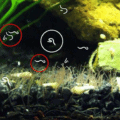

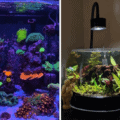

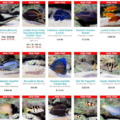
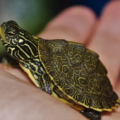
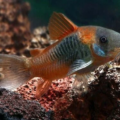



Hi,
Just wanted to thank you for taking the time to post such a detailed and helpful insight in to turtle lighting.. I have done so much reading on line about it and was still confused, until now. You have outlined and explained everything so much more clearly than all the rest I’ve read and I now understand what my long neck turtle requires and why without the confusion I was previously experiencing. So thankyou, thankyou, thankyou. 🙂
Can they survive with only heat emitter
Or do they need uvb bulb
They definitely need both uva and uvb bulbs, they don’t survive well with just a heat emitter as they are not getting the uv they need to stay happy and healthy, and the article you would’ve just read explains this and why…
Hi! My turtle habitat is in my bedroom, is it okay to turn off the lamp at night?
Hi,
Yes, absolutely.